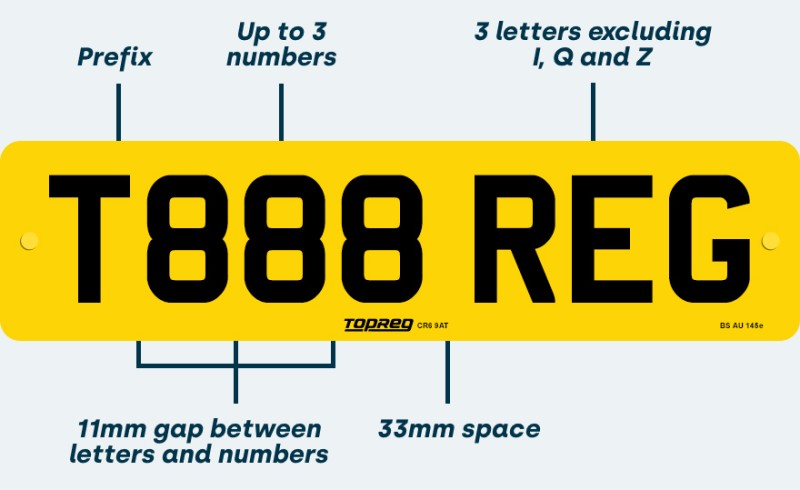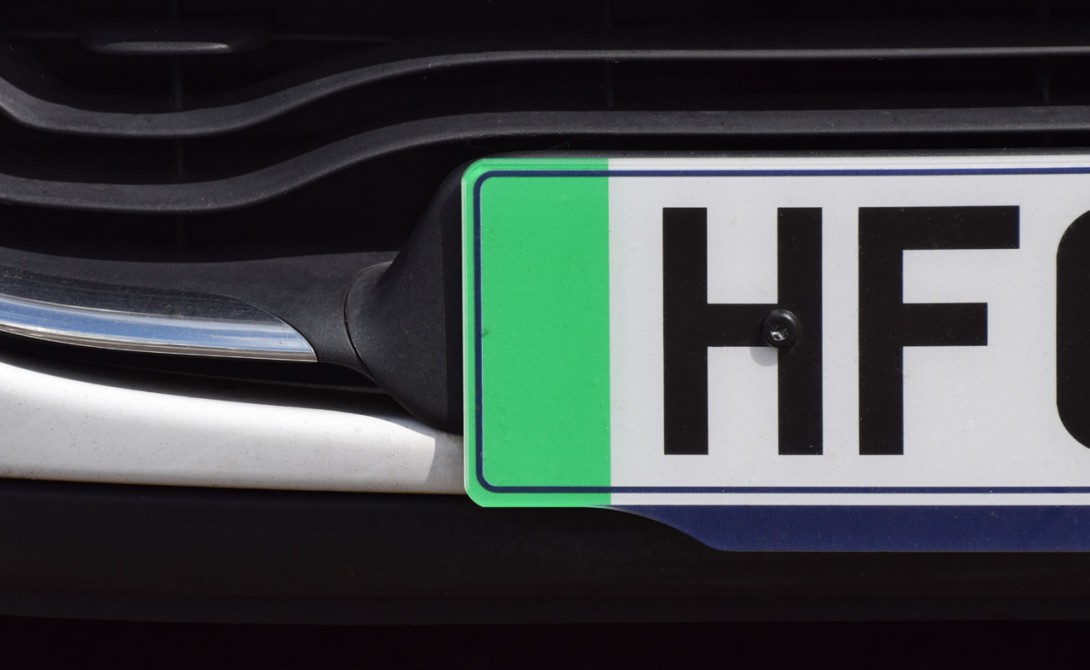There are a lot of rules and regulations that number plates must follow. It can be hard to keep up with them. However, that’s no excuse as failure to do so can result in failing your MOT, receiving a fine or even having your registration mark confiscated by the police.
To help you avoid all of these penalties, we’ve put together this article. So, follow us as we take a look at number plate spacing, the rules and laws you need to follow, and everything else you need to know.
General Rules
Okay, so you’ve just bought your new registration mark, and you’re now planning to get a new set of number plates printed. But before we get into spacing, make sure your new plates do the following:
- Is made from a reflective material
- Your front plate displays black characters on a white background
- Your rear plate displays black characters on a yellow background
- Not have any background patterns
- Shows the postcode and name of the supplier
Characters on a number plate can also have raised 3D lettering (also known as 4D plates), as long as they meet all other specifications. For more information, check out our article on 4D Number Plates.
All number plates manufactured for the UK must also meet the new British Standard requirements. These requirements set out the physical characteristics of the number plate, including their visibility, strength and reflectivity. The British Standard also requires each number plate to be permanently and legibly marked with the following information:
- The British Standard number (currently BS AU 145e)
- Name and postcode of the supplying outlet
What Is the Law for Number Plate Spacing?
The laws and rules that dictate number plate spacing can be found on the UK government’s website underneath document INF104. This document lays out the rules for spacing, as well as letter characters and sizes.
The characters on your number plate need to comply with the following spacing, height and size requirements:
- The space between characters must be 11mm
- The space between the age identifier and the random letters must be 33mm
- The margins at the top, bottom and side of the plate must be 11mm
- Vertical space between the age identifier and the random letters must be 19mm
- Characters must be 79mm tall
- Characters (except the number 1 or letter I) must be 50mm wide
- The character stroke (the thickness of the black print) must be 14mm
The use of ‘Characters’ here is referring to the individual letters and numbers found on your plate. The ‘Space between characters’ focuses specifically on the small gaps that can be seen between characters.
The ‘Space between the age identifier and the random letters’ is the legally required gap between the age identifier (T888 shown in the prefix example below) and the random letters (shown as REG below).

This same rule applies to private number plates. Similar to the example above, they must also have two separate groups.
Document INF104 also states that “vehicles with new or replacement number plates fitted from the 1st of September 2001 cannot be shown over 3 lines (unless the vehicle was first registered before the 1st of January, 1973) or if a vehicle is constructed before the 1st of January, 1980 and is registered in the historic tax class and is exempt from vehicle tax.”
What Are the Rules for Number Plates Fitted Before the 1st of September 2001?
UK number plates fitted before the 1st of September 2001 must meet the following requirements shown in the table below:
| Group 1 Number plates fitted before 01/09/2001 |
Group 2 Traditional number plates for vehicles made before 01/01/1973 |
|
|---|---|---|
| Space between characters | 13mm | 11mm |
| Space between the age identifier and random numbers | 38mm | 33mm |
| Character height | 89mm | 79mm |
| Character width (except the number 1 or letter I) | 64mm | 57mm |
| Character Stroke | 16mm | 14mm |
| Side margins (minimum) | 13mm | 11mm |
| Top and bottom margins (minimum) | 13mm | 11mm |
| Vertical space between the age identifier and the random numbers | 19mm | 19mm |
What About Vehicles Made Before the 1st of January 1973?
Vehicles made before the 1st of January 1973 may display traditional ‘black and white’ number plates (for example, white, silver or grey characters on a black plate). From April 2020, vehicles manufactured before the 1st of January 1980 are also able to display traditional ‘black and white’ number plates.
To do this, you must:
- Have applied to the DVLA
- Be registered within the ‘historic vehicles’ tax class
What are the rules on imported vehicles?
If your imported vehicle has a restricted space for a standard-sized number plate, then you may be permitted to display a plate with smaller characters and spacing. This applies specifically to vehicles that do not have European Community Whole Vehicle Type Approval.
The rules, in this case, are as follows:
- The space between characters must be 10mm
- Characters must be 64mm tall
- Characters (except the number 1 or letter I) must be 44mm wide
- The character stroke (the thickness of the black print) must be 10mm
What Are the Rules for Motorcycles and Tricycles?
The rules for motorcycle and tricycle number plate spacing vary from the ones stated above. They set out that:
- The space between characters must be 10mm
- The space between the age identifier and the random letters must be 30mm
- The margins at the top, bottom and side of the plate must be at least 11mm
- Vertical space between the age identifier and the random numbers must be 13mm
- Characters must be 64mm tall
- Characters (except the number 1 or letter I) must be 44mm wide
- The character stroke (the thickness of the black print) must be 10mm
Can I Change the Spacing on my Private Number Plate?
It is illegal to change the spacing on your private number plate. UK law states that you must not alter, rearrange or misrepresent the letters or numbers on your plates.
Take for example the private number plate BM WM3. It would be illegal to change the spacing so that it appears as BMW M3 or BMWM3.
So, in summary, your private number plate must look identical to your given registration mark.
If you are found to have changed your number plate’s spacing, you could find yourself with the following penalties:
- A large fine of up to £1,000
- Your registration mark being confiscated by the police
- Your vehicle failing its MOT
Order a set of plates using an existing registration with TopReg today. We produce custom plates using our in-house, industry-leading printers. We’ll also get them delivered to you within one business day!
